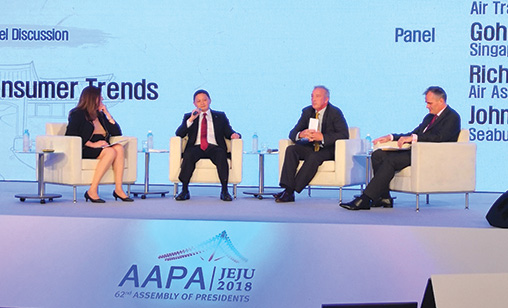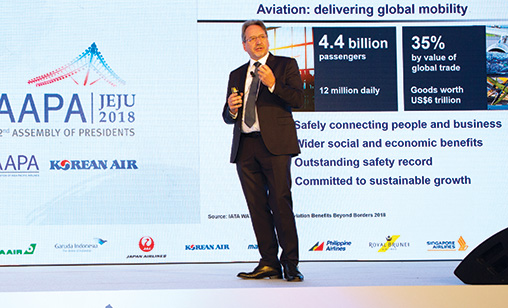Main Story
Bumps ahead if trade war escalates
When the region’s airline leaders gathered for the Association of Asia-Pacific Airlines Assembly of Presidents last month, they reported flying was thriving, but warned the year ahead held perils from higher fuel prices and trade wars to continuing infrastructure constraints.
November 1st 2018
So far in 2018, business at Asia-Pacific airlines has been in rude health. Read More » Despite pressure on margins from rising fuel costs and currency fluctuations, the region’s carriers are forecast to deliver substantial profits for the fourth consecutive 12 months to December 31.
Yet when airline leaders met on the South Korean island of Jeju for their 62nd Assembly of Presidents last month, it was felt the Sino/U.S. tariff war could dent consumer confidence and reduce cargo demand, critical to the operations and profitability of many Asia-Pacific airlines. Asian carriers shift more than one third of global air freight volumes.
 |
International air cargo demand has increased this year, but has moderated from the surge of 2017, said Association of Asia Pacific Airlines director general, Andrew Herdman, at the Jeju gathering.
His sentiments were echoed by two of the region’s largest air freight operators, Cathay Pacific Airways and Korean Airlines (KAL). “I think for the rest of this year it looks like (cargo) demand will be quite strong. Going into next year, obviously the future is unknown and there is a bit of uncertainty about it. There could be some bumps ahead,” Cathay Pacific CEO, Rupert Hogg said.
Korean Air (KAL) president and chief operating officer, Walter Cho, agreed. “This year the cargo market was relatively very strong, but I have a lot of concerns about next year’s market. It is still unknown and we are hoping for a better resolution between the two countries in conflict right now about this. Hopefully, they get to thinking in terms of consumers instead of ego.”
“Ultimately, trade wars are not good for trade and they’re not good for transportation, including air cargo so we would hope for resolution,” Herdman added. He said the International Monetary Fund (IMF) meeting in Bali in October had eased back its economic growth forecast from 3.9% to 3.7%.
Rising fuel costs are a second area of major concern for the industry. Herdman said year-on-year, the price of fuel has increased by about 40%, but from significant lows. “This is a big change and is that change being reflected in fares? It is one of the key pressures on airlines. The angle of growth of the average fuel price is steeper than airfares are recovering. Although air fares are rising they are still very affordable and the rate is below what it has been for the last 10 years,” said Herdman.
“Even though oil prices are rising air fares are having to edge upwards and they are feeling the squeeze in terms of margins while consumers are still getting the benefits of very affordable air fares.
“The industry is thriving in traffic terms but airlines must decide how much of the increase in fuel costs will be passed on to average fares and freight rates. Some people are afraid that higher oil prices and higher air fares will soften growth enthusiasm. But we saw that even when oil prices were way up in the $120 range people still travelled and growth still continued.”
Low-cost carrier expansion across the region also was an issue for discussion at the Assembly. Herdman said the key take away was that the full-service model is capturing 75% to 80% of the traffic, 80% of the revenues and the lion’s share of the profits.
 |
“But these distinctions are blurred as LCCs go international, medium and long haul and also adopt some of the practices of network optimization and co-operation from full-service airlines. At the same time, full-service carriers are moving towards an LCC model in the back of the plane in terms of base fares, unbundling and so on,” said Herdman.
In an a panel session, Singapore Airlines (SIA) CEO, Goh Choon Phong, said change is a constant in the industry and some changes challenge an airline’s business model and the way they serve their customers.
He said LCC penetration in Southeast Asia was in excess of 50%. “That’s huge and among the highest in the world. It all happened in the last 15 or 20 years. It changes the way consumers in our part of the world travel. With a trend like that, the question is ‘what do we have to do?’,” he said.
“I appreciate airlines in different countries will look at this in different ways. SIA has had to challenge the model we have operated for the last 60 or 70 years to participate in this growth. The outcome is we chose to embrace and create our own LCC to meet the demand of this new consumer trend and to be able to participate.”
Goh said that before the group launched its medium to long haul budget carrier, Scoot, SIA operated to a dozen destinations in China. Today, in co-operation with Scoot, which has now merged with Tigerair, the group flies to 29 Mainland cities from Singapore.
“That’s not small. We also operate 14 points to India. We could only do so because we are able to employ the LCC to points that would not have been viable with the full-service model. We think this portfolio approach gives us the flexibility to quickly adapt the right model to the right markets.”
As always, shortfalls in the construction of runways, terminals and air traffic management to cope with the region’s growth attracted analysis. “Air transport is widely recognized as a key contributor to economic and social development, built around strong global networks offering both passenger and air cargo services. The dynamic airline sector epitomizes the way in which the region’s carriers are at the forefront of global air transport industry development,” said Herdman. “Working together as a community, AAPA is determined to tackle the numerous challenges that face the industry.”
| Cockpit culture must change to address gender diversity In 2018, approximately three percent of the world’s pilots are female. An Assembly resolution called on governments to support the International Civil Aviation Organization’s (ICAO) New Generation of Aviation Professionals (NGAP) initiative by partnering with the aviation industry to invest in the education and training of future aviation professionals. “The association also calls on governments and other aviation stakeholders to promote best practices in human resource development including a renewed commitment to the further diversification of the workforce and gender equality,” a 2018 Association of Asia-Pacific Airlines (AAPA) Assembly of Presidents resolution said. Support should include expansion of teaching science, technology, engineering and mathematics (STEM) in schools to the introduction of flexible rosters that allowed aviation professionals to keep working when their personal circumstances changed, its member signatories said. AAPA director general, Andrew Herdman, said workplace diversity and gender equality were topics of active discussion within the AAPA and the industry more broadly. “We are driven from an operational culture. We have to adjust accordingly,” he said. “Still run the operation, but try to introduce a degree of flexibility [into the systems] because different people have different requirements. There are many, many opportunities ahead in this industry and it’s important this is well publicized. It’s a challenge and it needs more than talk.” |